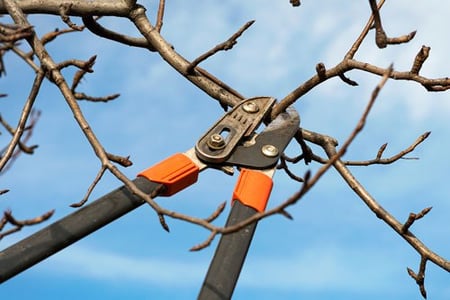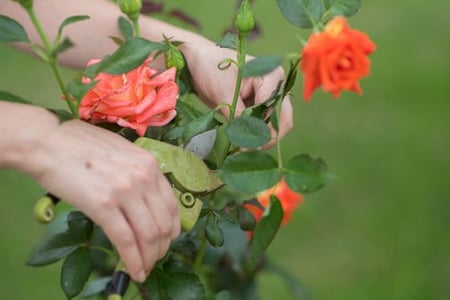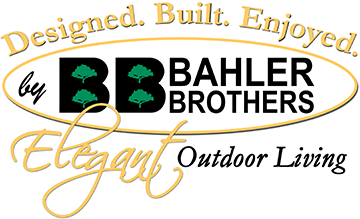
By: Jen Kloter on March 15th, 2018
Getting Your Yard in Shape: Proper Pruning Techniques
After the beating your yard took this winter, you’re probably looking at it, wondering how you’ll ever get it back in good shape. A few weeks ago, we shared some tips to help you get your yard ready for spring. There are many simple steps you can take to get your yard to where you want it to be for the warmer weather. And one of those steps is pruning.
Pruning – cutting away dead or overgrown branches and stems – is more than a cosmetic exercise. Pruning stimulates the fruitfulness and growth of trees and plants, when done the right way.
How do you properly prune to ensure the health of your trees and plants? This article will detail the appropriate time to prune your plants, where on it you should prune them, and which tools to use and how to care for them.
See how we stack up to our competition with our Contractor Comparison Worksheet
When to Prune Which Plants
The time to prune a tree, shrub, or flower depends on the unique plant. Before pruning any plants in your yard or garden, make sure to reference a local pruning calendar, similar to this one, to ensure you’re caring for the right plants at the right time. Pruning plants at the wrong time of the year can actually do more harm than good.
Trees
 Trees that shed their leaves in the fall are best pruned during the winter because their architecture is easily visible. Winter is also a time in which insects and diseases are minimal. To prune a tree, start by cutting off any of its dead, damaged or hazardous limbs. Then, you can clip any branches that are crossing one another or rubbing against each other. You should also clip its suckers – bushy clumps of young stems sprouting from a tree trunk.
Trees that shed their leaves in the fall are best pruned during the winter because their architecture is easily visible. Winter is also a time in which insects and diseases are minimal. To prune a tree, start by cutting off any of its dead, damaged or hazardous limbs. Then, you can clip any branches that are crossing one another or rubbing against each other. You should also clip its suckers – bushy clumps of young stems sprouting from a tree trunk.
To prune trees, follow the one-third and one-fourth rules. First, in a given season, never cut off more than one-fourth of a tree’s crown – the branches, leaves, and structures extending from its trunk or main stems. A tree’s main side branches should be one-third smaller than the diameter of its trunk, at minimum. And for most deciduous trees, refrain from pruning more than one-third of your tree’s total height (from the bottom, up). This illustrated post from WikiHow explains tree pruning in great detail if you would like to learn more.
Shrubs
As with trees that shed their leaves, deciduous shrubs should also be pruned in the winter.
As the season changes to spring, though, you should prune both broad-leaved evergreens and ornamental grasses. Any winter-damaged foliage should be pruned from shrubs – plants such as boxwood or hollies. Ornamental grasses should be trimmed as close to the ground as possible. For quick and simple pruning, you can tie the tops of the grasses.
As soon as spring turns to summer, it’s time to hedge broad-leaved shrubs and start pruning evergreen shrubs such as yews and junipers, and spring-flowering shrubs such as forsythia, lilacs, and rhododendron. Prune evergreen shrubs just as their growth begins to cover their cut tips and thin the inners of the bush to make sure its outer foliage won’t become excessively thick.
Spring-flowering shrubs form their buds for the following year during the summer, so it's important to prune these soon after they flower to control their size and shape. Waiting too long to prune spring-flowering shrubs will mean cutting off buds that would have grown next year. Cut off any flowers that are withering to encourage further blooming and direct growth into its blooms (known as deadheading). Removing the oldest stems will maintain its flowers’ size and keep it blooming healthfully on new stems in the future. If the shrubs are overgrown, rejuvenate them by trimming them down to about 8 inches.
Flowers
 Flowers that bloom in the summer on trees, shrubs and vines bloom on new growth. These include flowering shrubs such as roses and hydrangeas. By pruning these flowers in the early spring – along with eventual fertilization and adequate moisture – you’ll maximize their size and volume. Start by removing any stems that are overcrowded, damaged, or dead. You can them shape them or cut them back to your preference.
Flowers that bloom in the summer on trees, shrubs and vines bloom on new growth. These include flowering shrubs such as roses and hydrangeas. By pruning these flowers in the early spring – along with eventual fertilization and adequate moisture – you’ll maximize their size and volume. Start by removing any stems that are overcrowded, damaged, or dead. You can them shape them or cut them back to your preference.
Early spring is also the time to prune semi-woody perennials such as butterfly bushes and Russian sage. To promote strong, new stems and the most vibrant flower, trim their stems back to roughly four inches.
Come fall, you should prune perennials and annuals, deadheading them to extend their flowering and promoting another full bloom. Unlike some plants, woody plants don't produce a callus during the fall – a protective tissue that covers a plant’s wound. Without this protection, insects, bacteria, and fungal spores could enter a flower’s open wounds. Thus, cut these flowers down and mulch where you plant them to promote next year's growth.
Using the Right Tools
Using the proper tools is an essential element of your pruning process and will make your efforts much easier. We recommend you own tools such as anvil, bypass, and hedge shears, loppers, pole and tree pruners, and pruning saws.
- Pruning shears
The most-used pruning tool for shrubs and flowers, pruning shears are a hand-held tool capable of cutting branches and twigs no more than ¾” thick. Bypass shears are like scissors and are good for pruning live stems. Anvil pruning shears work well to cut dry branches and stems. Lastly, hedge shears can cut branches up to 2 ¼” thick and are great for hedges (of course), small shrubs, evergreens, and deadheading perennials.
- Loppers
Similar to typical hand shears in function, loppers have thicker blades and a longer handle, making them great for pruning branches up to 2 ½” thick. Loppers are also made in anvil, bypass and ratchet forms.
- Pole and Tree Pruners
A pole or tree pruner is an essential tool used for light pruning or reaching dead wood. No need for a ladder, most tree pruners are at least eight feet long and can cut through branches up to 1 ¼” thick.
- Pruning Saws
Used mainly for trees or thick bushes, pruning saws can typically cut through branches up to 5” thick. They’re typically made with very sharp, medium-length blades to make cutting large branches relatively easily. Their blades can be straight or curved, and their handles can be curved to improve the cutting angle for curved tree branches.
You can buy any of these useful tools at your neighborhood hardware store or garden center. We recommend buying from a store who provides good customer service and offers a good return policy.
Caring for Your Tools
No tool is effective if it’s not in proper condition. Keeping your tools clean and sharp will make pruning easier for you, and will be better for your plants. Clean your tools after every time you use them. Carefully check your tools’ sharpness before using them, and if they’re remotely dull, sharpen them with diamond files. Of course, make sure you store your tools in a dry, covered area to prevent water from rusting and deteriorating your blades.
Put Your Yard Pruning Techniques to Good Use
Using proper pruning techniques will ensure that your yard and garden not only look great, but that their trees and plants are healthy and thriving. For some, the extent of this work can be too much to manage. If you’re looking to take your yard to the next level but need help, you might be interested in our comprehensive landscaping services.




